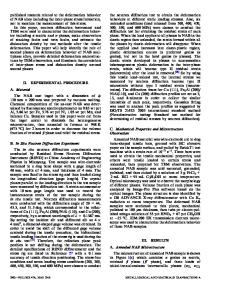Early stages of reduction of nickel oxide single crystals: An investigation by transmission electron microscope
- PDF / 2,600,799 Bytes
- 6 Pages / 583.28 x 777.28 pts Page_size
- 53 Downloads / 335 Views
DURINGthe past thirty years, studies of gas-solid reactions have received considerable attention 1due to their importance in widely varying branches of technology. One such important technological application is the extraction of metals from their ores by gaseous reduction using hydrogen or carbon monoxide. The blast furnace reduction of iron oxides to iron provides the very important example of such a reaction and much time and effort has been devoted toward the measurement and explanation of the kinetic and thermodynamic factors involved.2-7 In the nonferrous field important examples include the production of nickel metal from nickel oxide and copper from copper sulfide ores and again much work has been directed to the macroscopic measurements and explanation of the rate processes involved.8-H In all of these investigations the emphasis has been to measure macroscopic properties of the system such as the variation of the weight of the sample with time using gravimetric methods, as these are basically straightforward experiments to undertake and can yield sufficient data with which to characterize the system. Such data can then be manipulated to produce a mathematical formulation of a general rate equation for the system as has been done successfully for nickel oxide reduction? However, as Turkdogan has pointed out, 2 for a better understanding of the various factors influencing the rate phenomena a detailed investigation should be made of the processes involved over the entire range of variables of practical importance. In this respect, recent years have seen the modification of high voltage transmission electron microscopes to incorporate small environmental cells in which the specimens can be heated and subjected to gaseous environments while being viewed directly on the microscope screen. In this way resolutions of J. W. EVANS is Principal Investigator, J. A. LITTLE is Postdoctoral Scientist, and K. H. WESTMACOTT is Principal Investigator, Lawrence Berkeley Laboratory, Materials and Molecular Research Division, Berkeley, CA. Manuscript submitted October 29, 1979.
approximately 50~ can be obtained, such resolutions depending primarily on the particular gas and pressure used. Investigations dealing with the reduction of oxides at the microscopic level have recently been conducted using such facilities and in particular the reduction of the iron oxides has been investigated)2-14One important phase of oxide reduction which has not been extensively investigated is the nucleation of the metallic phase upon the oxide substrate, a phenomenon which may be very important in its effect on subsequent reduction behavior. Those studies which have concerned themselves with this problem have used high power optical microscopy ~5,~6and so the natural development of this research is to use the transmission electron microscope. R a t has recently reviewed some of the basic concepts concerning the nucleation process during reduction reactions ~6 and related the intrinsic rate of reduction of wustite to the optical microscopic me
Data Loading...











